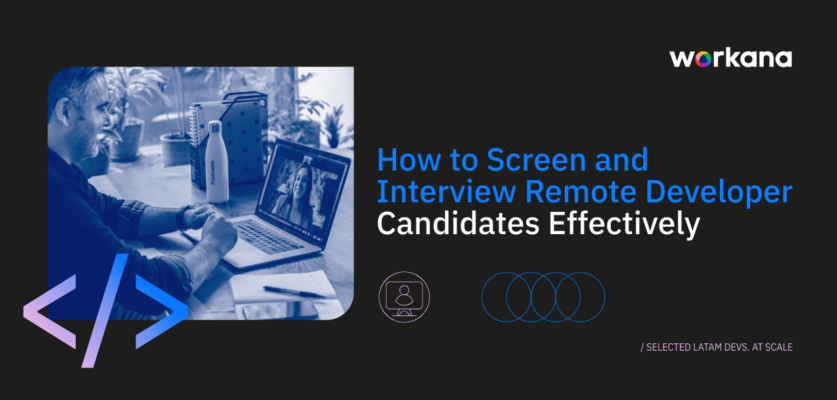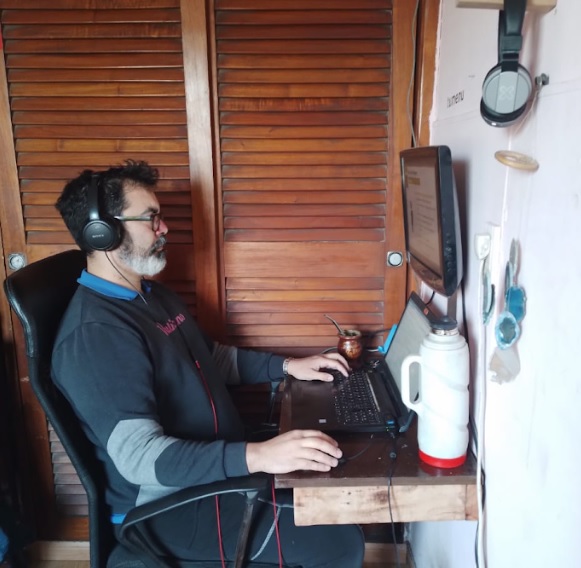The impact of bad hires is visible in every company, but it’s especially noticeable when it comes to IT professionals and programmers. Between hiring costs, severance, and project delays, the wrong candidate can cost companies up to 50% of their annual income.
This is a very real risk, and there’s no way for companies needing developers to avoid it because of the factors that can make finding the right talent difficult. The first factor is that there’s an overabundance of unqualified applicants and a significant scarcity of candidates with the right skills.
And if that weren’t enough, there aren’t many Technical Recruiters who are specialized in evaluating candidates’ technical abilities in programming languages, problem-solving, and achieving complex objectives.
How can I avoid a bad hiring experience if I need a remote developer?
The best way to decrease the probability of a bad IT hire is to invest time and resources in a recruiting process that prioritizes the four following key points:
- Consulting an internal or external professional with enough expertise in the subject
- Broadening the talent pool
- Process automation
- A holistic analysis of technical skills, soft skills, and contextual viability
These four factors are reflected in three comprehensive phrases that cover the job or profile description, selecting viable candidates, and the interview and skill assessment processes. When done well, each of these phases save time and money and reduce risks in the long run.
Phase 1: Job or Profile Description
The world of programming is extremely broad. Two software engineers with a similar formal education can have very different skills and specializations like cloud infrastructure, operating systems, data analysis, mobile apps, front and back end, etc.
In addition to technical skills in different programming languages and apps, you’ll have to list the experience requirements with different industries, taking on different responsibilities in a team, and even soft skills for communicating with clients and other departments in the company.
There are thousands of programmers and developers simply because there are an infinite number of specific requirements in the industry. To create a job or profile description, you’ll need to define the objectives of the project, its deliverables, the required skills and tools, and the role that each new talent will play on the team, at least at the beginning.
A lot of times the people in charge of recruiting who don’t have specific IT training don’t have a clear answer to these questions, and even if they do have them, they don’t understand what they mean because the questions are formulated with highly technical language and designed to be answered by people with extremely specialized knowledge. That’s why it’s fundamental that you work side by side with someone who has this general knowledge during these first three phrases.
There are two options. The first is to invite one of your programming team leads and find a way to combine their responsibilities with supporting the recruiting team.
However, what if a startup is building their developer dream team from scratch or if their developers are already working at full capacity? In this case, it’s much better to invest in an external consultant with a lot of experience recruiting tech profiles that will work with you for a few months in order to build job descriptions and assess candidates.
In the first stage, you’ll need to define the following:
- The candidate’s exact responsibilities
- The technical skill sets that the candidate will need to have
- The technical conditions that are required (for example certain internet speeds, processors with certain capacities)
- The types of projects and objective results that candidates will have to have proven experience in
- The role that the candidate will have within the team and the soft skills required for it
- The main values that you’re looking for in order to ensure a good cultural fit
This last point may seem irrelevant, but according to specialized recruiting agency Robert Walters, up to 73% of professionals have left companies because of bad cultural fits.
At this point, you might be wondering why we haven’t added anything about credentials or academic performance. This is completely deliberate. One of the biggest recruiting trends is that companies are starting to forgo college degree requirements and focus more on proven skills and experience with similar projects.
Phase 2: Filter and select viable candidates
Selecting from a wide enough talent pool and looking for developers in the right places is crucial in this phase. Since we’ve already talked about this topic at length, we’ll assume that you’ve got it covered.
The main objective is to attract viable candidates and select the best that pass the technical assessment and interview stages. There are two critical components to achieving this: the amount of information that you can get from each candidate and the automated tools that help you select and discard applicants. This, of course, is assuming that you’re selecting from a wide, cross-border talent pool.
The CV is still used as a general overview of a developer’s skills and experience, but the reality is that recruiters are focusing more and more on tangible aspects like a candidate’s professional portfolio on project platforms with an open code that allows them to analyze matters objectively. These matters can include reputation, followers, recent activity, experience level, type of projects, etc.
Once the opening is posted, you’ll have to add a few screening questions that will help filter out certain candidates and require attaching certain test files as part of their application. This helps to prevent resume spamming and saves time.
Finally, a lot of companies are opting to look over candidates’ social media and professional network accounts in order to ensure that the candidates don’t have any questionable character traits or problematic behavior that could be a liability for the company.
This is a lot of information, and that’s where automation comes into play. There are a lot of solutions on the market that do exactly this, but generally they’re designed for talent recruitment consulting agencies that are specialized in recruiting for third parties. They can also be very expensive for companies that only want to hire a limited number of collaborators annually.
When it comes to hard programming skills, you can also automate a large part of technical evaluations through tools that we’ll mention below. Generally speaking, though, this isn’t done often because every evaluation costs the company, and the more exclusive the open position, the higher the number of (unqualified) candidates can be.
Phase 3: Evaluation and selection
This phase’s main objectives are to differentiate between the candidates that appear similar at first glance and prove that these candidates are who they are in their application.
Almost all recruiting agencies agree that between 40 and 80% of candidates provide ambiguous or outright false information on their CVs (Pre-Employment Testing Criteria; Careerbuilder research).
Generally, the more unreliable information has to do with the amount of experience a candidate has working with a particular technology, their real soft skills, and their level of expertise in a second language.
For example, given the types of specializations that are common in this industry, it’s suspicious for a candidate to claim that they’re experts in three or more programming languages, especially if they’re young. However this doesn’t mean that they should be written off either.
The evaluation and selection stage can be divided into two sections:
Hard skills
This refers to the test that assesses programming skills, problem-solving and the ability to create new solutions. Automated evaluation tools tend to be used for this type of test because they allow reviewers to:
- Preconstructed coding tests to evaluate specific skills
- Online and real-time interviews during programming to prevent cheating
- Programming challenges or real-time hackathons between different candidates
- Projects that developers can complete with their own est of tools and upload to the platform
Right now, some of the most popular options are Codility, ChallengeRocket, HackerRank, and CodeSignal.
You can also ask questions that point to a candidate’s general knowledge and their work style. For example, you can ask them things like, “What do you know about a software development life cycle?” or “What model do you prefer to use and why?”
Soft skills
How a candidate performs on a skill test can give you clues about their soft skills like their ability to analyze, creativity, and working under pressure. However, you can get a clearer idea of what their soft skills are like by interviewing them one on one and asking them key questions like:
- Tell me about a major problem in a code that was the result of a mistake you made and how you solved it
- What was the last class/skills update training that you took and when?
- What’s your greatest weakness as a developer?
- What teamwork-related challenges are the most difficult for you to overcome?
- What strategies do you use to maintain a work-life balance?
- How would you explain this project’s requirements to someone who doesn’t know anything about programming?
Finally, don’t forget to talk more in detail about topics like technical viability, running internet speed tests, proving hardware requirements and schedule compatibility, etc.
Keep an eye out for our upcoming articles where we’ll discuss the next phases in depth: the hiring process and onboarding.
Need help recruiting remote developer candidates?
At Workana, we’re speaking from experience. Our unique process for evaluating and identifying candidates in Latin America allows you to hire the best talent with all the skills you need in less than 15 days. Best of all, you do this while saving up to 30% on recruiting and hiring costs.
See the difference for yourself with a seven-day risk free trial and find out why we have an 85% fill rate.
You may also be interested:
- The Numbers Behind the Devs and IT Talent “Shortage”
- New Hiring Methods and Their Benefits
- How to migrate your startup to a 100% remote model
- Pro Tips For Managing Remote IT Talent Teams









